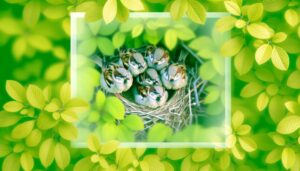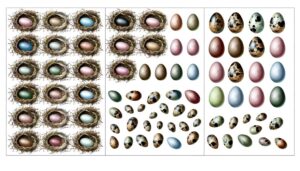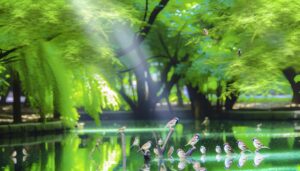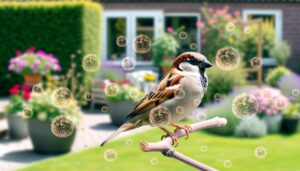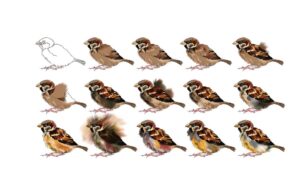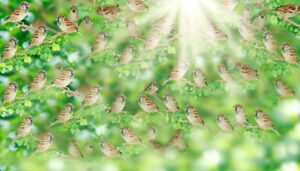Which Bird Lays Blue Eggs?
House Sparrows (Passer domesticus) occasionally lay blue eggs, primarily due to the deposition of the pigment biliverdin. This phenomenon, though uncommon, results from genetic factors that regulate pigment pathways and environmental influences like climate and urbanization.
Blue eggs may confer adaptive advantages, such as higher parental investment. Compared to consistent blue-egg layers like American Robins, House Sparrows exhibit diverse egg coloration.
Understanding these ecological and genetic influences on egg pigmentation helps in avian studies and conservation efforts. Exploring this further can provide additional insights into how these factors affect House Sparrow populations.
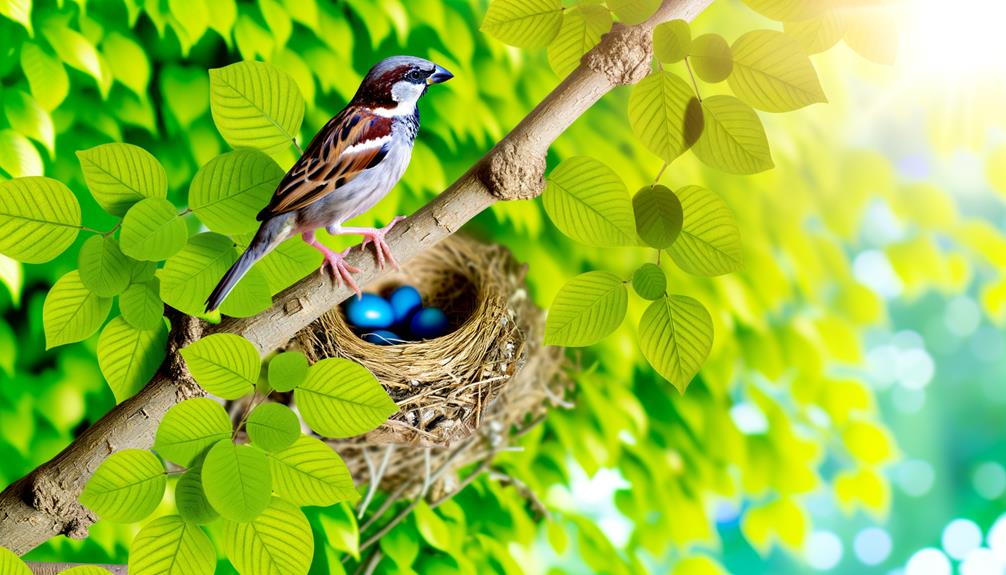
Key Takeaways
- House Sparrows occasionally lay blue eggs due to biliverdin deposition.
- Blue egg occurrence in House Sparrows is influenced by genetic and environmental factors.
- Blue eggs in House Sparrows may correlate with higher parental investment.
- American Robins and Eurasian Blackbirds consistently lay blue eggs.
- Blue egg pigmentation serves as an indicator of environmental adaptability and health.
Overview of House Sparrows
As one of the most widespread and adaptable bird species, the House Sparrow (Passer domesticus) has been extensively studied for its behavioral ecology and interactions with urban environments.
This species exhibits remarkable plasticity, thriving in diverse habitats ranging from rural farmlands to densely populated cities. House Sparrows exhibit strong site fidelity and social structures, often forming large, stable flocks. Their diet is omnivorous, including seeds, insects, and human food scraps, which facilitates their success in anthropogenic landscapes.
In-depth studies have documented their nesting behaviors, which include utilizing man-made structures, thereby increasing reproductive success. Researchers have also noted their role as bioindicators for environmental changes, making them critical subjects for ecological and environmental science.
Typical Egg Characteristics
The typical egg characteristics of house sparrows include notable variations in egg color, ranging from white to pale blue with speckled patterns.
Detailed observations reveal that the shell texture is generally smooth, with occasional instances of slight glossiness.
These characteristics are supported by evidence from ornithological studies documenting the reproductive traits of the species.
Egg Color Variations
Egg color variations in house sparrows (Passer domesticus) typically range from white to pale blue, often speckled with brown or gray markings. These variations are influenced by genetic and environmental factors.
Studies have indicated that the pigmentation process involves porphyrins and biliverdin, which contribute to the blue and green hues respectively. The speckling is believed to provide camouflage against predators, enhancing egg survival rates. Observations show that the intensity and pattern of speckling can vary significantly even within the same clutch.
Additionally, nest site conditions, such as light exposure and substrate type, can affect the visibility and appearance of these eggs. Understanding these color variations provides insight into the adaptive strategies employed by house sparrows for reproductive success.
Shell Texture Details
Shell texture in house sparrow eggs typically exhibits a fine-grained, smooth surface that occasionally features slight shininess, reflecting adaptive variations necessary for reproductive success.
The finely textured surface minimizes potential abrasions during incubation, thereby enhancing egg viability. Microscopic examination reveals a consistent calcareous composition, indicative of ideal calcium deposit during ovogenesis.
This smooth shell structure is hypothesized to facilitate efficient gas exchange while maintaining structural integrity against environmental stressors. Slight shininess, observed under controlled lighting, suggests the presence of cuticular layers that may offer additional protective benefits.
Such textural characteristics are essential for embryonic development, providing a balanced microenvironment that supports consistent thermal regulation and moisture retention, thereby maximizing hatchability in various ecological settings.
Blue Egg Phenomenon
Intriguingly, the blue egg phenomenon in house sparrows presents a fascinating area of study, revealing significant insights into avian reproductive strategies and environmental adaptations.
This uncommon pigmentation is primarily attributed to the deposition of biliverdin in the eggshell during formation. Biliverdin's presence not only imparts the blue coloration but may also serve adaptive functions, such as enhanced camouflage against predation and potential benefits for embryo development.
Empirical studies indicate that blue eggs in house sparrows might correlate with higher parental investment and superior nest-site selection. Additionally, environmental factors, including ambient light and vegetation, further influence the prevalence of blue eggs.
Understanding this phenomenon provides a broader comprehension of the intricate balance between genetic predispositions and ecological pressures in avian species.
Genetic Influences
The occurrence of blue eggs in house sparrows is strongly influenced by genetic factors, with specific alleles linked to the biosynthesis and deposition of biliverdin in the eggshell.
Biliverdin, a bile pigment, imparts a blue-green hue when integrated into the eggshell matrix. Studies have identified candidate genes responsible for biliverdin production and transport, such as those involved in heme metabolism and pigment deposition pathways.
Genetic variations in these alleles contribute to the phenotypic expression of blue egg coloration. Detailed genetic analyses, including genome-wide association studies (GWAS), have corroborated these findings, indicating a heritable component.
Experimental crossbreeding has further demonstrated Mendelian inheritance patterns, underscoring the pivotal role of genetics in this trait.
Environmental Factors
Understanding the environmental factors influencing the egg coloration of house sparrows involves examining climate influence patterns, urban habitat impacts, and pollution effects.
Evidence indicates that temperature fluctuations and seasonal variations can affect pigment deposition in eggshells.
Additionally, urban environments and exposure to pollutants have been observed to correlate with changes in eggshell coloration, suggesting a complex interplay between environmental stressors and reproductive biology.
Climate Influence Patterns
Climate influence patterns significantly impact the reproductive success and habitat suitability for house sparrows, particularly through variations in temperature, precipitation, and seasonal shifts. These climatic factors directly affect the availability of resources and nesting conditions. Empirical studies have shown that fluctuations in these variables can lead to changes in reproductive timing, clutch size, and chick survival rates.
The following are key climate influence patterns:
- Temperature Variability: Extreme temperatures can alter metabolic rates and food availability.
- Precipitation Patterns: Changes in rainfall influence the abundance of insects, a primary food source.
- Seasonal Shifts: Altered breeding seasons can mismatch food peaks and chick rearing periods.
- Storm Frequency: Increased storms can destroy nests and reduce chick survival.
Understanding these patterns is essential for predicting future impacts on house sparrow populations.
Urban Habitat Impact
Urbanization imposes substantial environmental pressures on house sparrow populations, influencing nesting sites, food availability, and exposure to pollutants. Urban habitats reduce the availability of natural nesting sites, forcing sparrows to adapt to artificial structures. Altered food resources, mainly due to reduced insect populations and increased human-provided food, impact their diet and nutrition. Additionally, urban areas present increased risks from noise and light pollution, which can affect reproductive success and behavior.
| Environmental Factor | Impact on House Sparrows | Evidence-Based Observations |
|---|---|---|
| Nesting Sites | Decrease in natural sites | Adaptation to buildings |
| Food Availability | Reduced insect numbers | Reliance on human food |
| Noise Pollution | Behavioral changes | Disrupted communication |
| Light Pollution | Reproductive effects | Altered breeding patterns |
These factors collectively challenge the survival and adaptability of urban house sparrow populations.
Pollution Effects Analysis
Numerous studies have documented the detrimental effects of various pollutants, including heavy metals and particulate matter, on the physiology and behavior of house sparrows in urban environments. These environmental contaminants have been shown to impact:
- Reproductive Success: Elevated levels of heavy metals, such as lead and cadmium, have been correlated with decreased fertility rates and malformed offspring.
- Respiratory Health: Fine particulate matter (PM2.5) contributes to respiratory distress and increased mortality.
- Behavioral Changes: Exposure to pollutants can alter foraging behavior, leading to reduced food intake and nutritional deficits.
- Immune Function: Pollutants can suppress the immune system, making sparrows more susceptible to diseases.
These findings underscore the urgency of mitigating pollution to preserve avian biodiversity in urban ecosystems.
Comparative Species
One notable aspect of studying avian reproductive behavior is the comparison of egg coloration among different species, with the House Sparrow (Passer domesticus) and its occasional blue eggs providing a particularly intriguing case. Comparative studies reveal that while House Sparrows typically lay pale, speckled eggs, instances of blue eggs arise under specific environmental conditions.
Such variability contrasts with species like the American Robin (Turdus migratorius), where consistent blue egg coloration is standard. Research indicates that egg color can be influenced by genetic factors, dietary components, and environmental stressors.
For example, the Eurasian Blackbird (Turdus merula) also exhibits blue eggs, suggesting adaptive significance possibly linked to camouflage or temperature regulation. The comparative analysis underscores the complexity and diversity of avian reproductive strategies.
Significance for Birdwatchers
Understanding the variability in egg coloration among avian species, such as the intermittent blue eggs of the House Sparrow, holds significant implications for birdwatchers. They rely on these visual cues for accurate species identification and nesting behavior observations. This variability can enhance the birdwatching experience and improve data collection accuracy.
Key aspects for birdwatchers include:
- Species Identification: Differentiating species based on egg color aids in precise documentation.
- Nesting Patterns: Observing blue eggs helps in understanding nesting cycles and habitat preferences.
- Behavioral Studies: Egg coloration can indicate parental investment and reproductive strategies.
- Conservation Efforts: Accurate identification through egg color supports targeted conservation measures.
These elements underscore the importance of recognizing egg color variations in avian studies.
Scientific Insights
Recent research has revealed the biochemical processes underlying the blue pigmentation of House Sparrow eggs, shedding light on the genetic and environmental factors that influence this phenomenon.
The blue coloration is primarily attributed to the deposition of biliverdin, a bile pigment, within the eggshell. Genetic studies have identified specific alleles that regulate biliverdin synthesis and deposition.
Environmental aspects, such as diet and habitat, also play a significant role by affecting the availability of precursors necessary for pigment production. Detailed spectrophotometric analysis has confirmed the presence and concentration of biliverdin, establishing a strong correlation with the observed blue hue.
These insights provide a thorough understanding of the multifaceted mechanisms driving egg pigmentation in House Sparrows.
Conservation Implications
The elucidation of the genetic and environmental determinants of blue egg pigmentation in House Sparrows carries significant ramifications for conservation strategies. Understanding these factors can inform targeted efforts to preserve genetic diversity and habitat specificity.
Key implications include:
- Habitat Preservation: Identifying environments that promote blue egg-laying can prioritize areas for habitat conservation.
- Genetic Diversity: Ensuring the survival of varied phenotypes within House Sparrow populations enhances adaptability to changing environments.
- Population Monitoring: Blue egg pigmentation can serve as an indicator trait for monitoring population health and dynamics.
- Climate Change Adaptation: Studying how environmental factors affect blue egg pigmentation can offer insights into how House Sparrows may adapt to climate fluctuations.
These insights provide a foundation for evidence-based conservation efforts.
Conclusion
The phenomenon of blue eggs in House Sparrows defies conventional avian reproductive norms and challenges existing scientific paradigms. Genetic mutations, environmental pressures, and interspecies breeding intricacies coalesce in an extraordinary convergence, producing these rare and visually stunning eggs.
These findings not only captivate ornithologists and birdwatchers alike but also amplify the urgency for thorough conservation efforts. This extraordinary intersection of genetics and environment underscores the importance of continued research to unravel the enigmatic complexities of avian reproduction.

